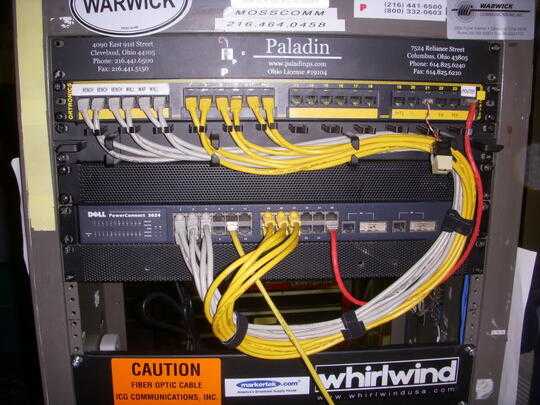7
1
In most photos I see of users' networks I see what appears to be a switch which then runs all the cat5/cat6 wires to another box that looks like a switch.
What is the purose of doing this?

7
1
In most photos I see of users' networks I see what appears to be a switch which then runs all the cat5/cat6 wires to another box that looks like a switch.
What is the purose of doing this?

12
The kind of cabling you use for in-wall installation is often different to the wire you use in a conventional cable for patching.
A Patch panel is typically used as a place to terminate (connect) the in-wall cabling, with the other ends usually connected to wall sockets out in offices or classrooms. Since none of this wire moves, it isn't subject to wear and tear (metal fatigue) that occurs with flexible cables.
Patch cables are then used to connect the patch points to the actual network equipment. This allows for flexibility - patches can be changed to accommodate changing business (or technical) requirements, without touching the wires inside the walls.
5
The top device is not a switch, it's a patch panel :)
Thats what I was kind of thinking it was called, it still seems kind of useless to me at the moment though – JasonDavis – 2010-03-17T23:26:32.530
The article should shed some light as to why they are used :) – John T – 2010-03-17T23:29:35.360
2
It's a patch panel, as others have stated -- however, there is one really awesome reason you'd do so if that had been a switch.
1
The previous answers are correct, but in general it is also possible to have multiple Ethernet connections between two switches. Normally, all but one of these are "blocked" by the (R)STP; these are backup links. In more exotic networks, there will be Virtual LANs to logically organise groups of users and to trim the broadcast domain (leading to a more efficient network). Some switches allow for a spanning tree per VLAN, which can take advantage of the some of the "blocked" links, using more of the network's capacity.
PVST doesn't have anything to do with how many cables you use. Even if you were using multiple VLANs, you'd most likely just one cable to carry them all between switches (it's called trunking). – Alex – 2010-03-18T04:58:07.790
Great explanation, +1 from me. You may also want to mention length limitations and how it relates to horizontal cabling. These panels are typically found in a telecommunications room in each floor in multi-floor buildings. Quite handy for accommodating business changes, as you've already covered :) – John T – 2010-03-17T23:38:42.000
thanks that makes sense, when you say that the patching cables are generally different from the in-wall cables, do you mean the patch cables are generally better quality cable? – JasonDavis – 2010-03-17T23:48:46.297
1@jason, the other way around. In walls, cable is usually run through risers and plenums, which requires more expensive riser or plenum certified cable. If it is just going through raceways for example, regular CAT will suffice, but the difference he was referring to was probably my first point. Patch cables typically don't run through these environments so regular (less expensive) CAT cables are used. – John T – 2010-03-17T23:56:15.360